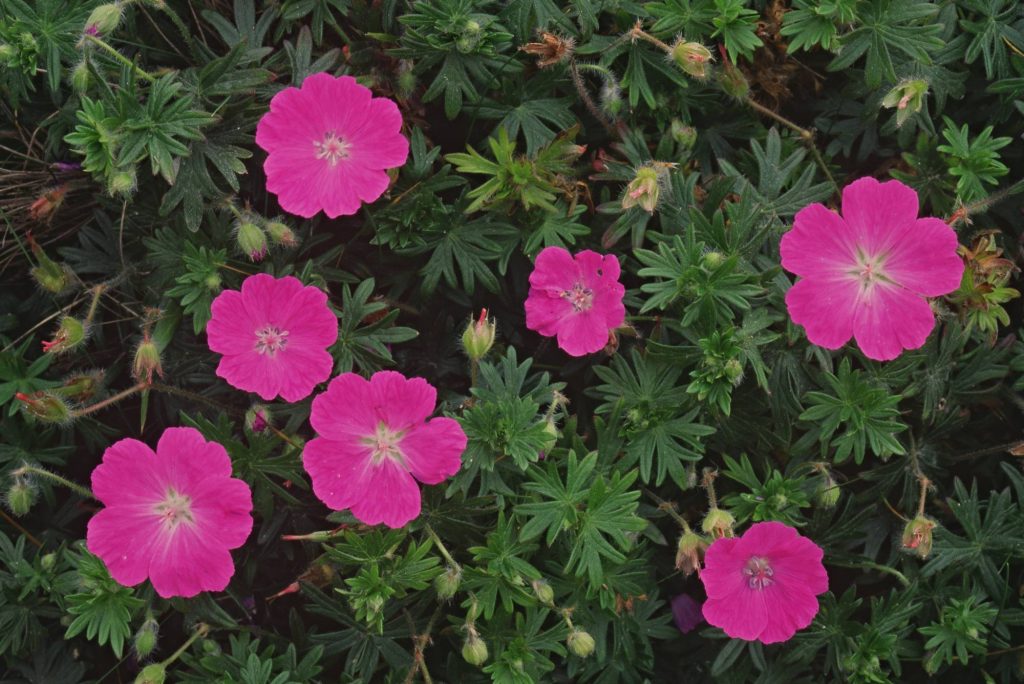In summer, The Lizard explodes into a blaze of colour. Whether you are walking along the cliffs, across the heaths, or through woods and meadows, there is always something to see. To whet your appetite, here is just a small selection of some of the wonderful plants you are more likely to spot in the summer in some of the different habitats across The Lizard.
Its name suggests that Bloody Crane’s-bill ought to be red. However, it is in fact a deep and vivid magenta, a colour that subtly fades as summer marches on. Usually associated with chalk and limestone habitats, here it enjoys the serpentine soils. It gets the name Crane’s-bill from its beak-shaped autumn fruit.
Habitat: Serpentine cliffs and rocks
Photo: Bloody Crane’s-bill (© Natural England/Peter Wakely)


The Cornish people were drinking Chamomile tea well before it became trendy. A popular plant in horticulture (think Chamomile lawn), Wild Chamomile has been in decline, but manages to thrive on The Lizard. Gently crush one of its feathery leaves to get the full benefit of that wonderful apple smell.
Habitat: Coastal grassland
Photo: Wild Chamomile (Amanda Scott)
Its name is a pretty good clue to where you’ll find the vivid yellow, starry flowers of Bog Asphodel. It likes to grow in damp, boggy heathland. This habitat is poor in nutrients; this gained the plant a reputation for causing brittle bones in sheep feeding on it, but the cause was in fact the lack of calcium, an essential nutrient for the animals, in the soil. Even so, you’ll still sometimes hear Bog Asphodel called Bonebreaker.
Habitat: Damp/boggy heathland
Photo: (© Natural England/Allan Drewitt)


From mid-summer, you can spot the purple-tinged flowers and leaves of Sea-holly on sand dunes and beaches. Loe Bar is a good place to find this prickly plant. It’s not in fact a relation of the familiar woodland Holly; it’s a member of the Carrot family (Umbellifers).
Habitat: Sand dunes and sandy beaches
Photo: Sea Holly at Loe Bar (Amanda Scott)
Flowering from mid-July into the autumn, Devil’s-bit Scabious can be found in meadows, woodland glades and heathland. Importantly, it’s the caterpillar foodplant of the Marsh Fritillary, a threatened butterfly species, which has populations on The Lizard.
Habitat: Woodland, meadows, heathland
Photo: Devil’s-bit Scabious on Mullion Cliffs (Amanda Scott)


To finish with one of The Lizard’s famous rarities, in mid-summer try to spot the tiny Yellow Centaury. It’s easy to miss, but is associated with the trackways that criss-cross the heathlands. The Grochall track from Mile End (on the A3083) which heads towards Kynance Cove is a good place to look.
Habitat: Heathland, especially the old trackways
Photo: Yellow Centaury (Amanda Scott)
If you want to find out more about plants you can see on The Lizard, why not browse our online library of plant species: for each listed, there are photographs and a description to help you to identify them.
